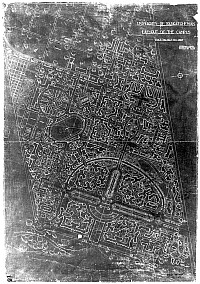
The Brown and Vallance plan for the campus
was accepted in September of 1909. In a province and city dominated by
the grid pattern, their plan set the University off from its surroundings
and declared its uniqueness in two simple ways, first by placing its main
axial at an angle to the east-west line (it ran back from a small river
bank valley known as Devil’s Dip at an angle 28 ½° south
of due east), and secondly by introducing roads that curved when they
did not have to, a remarkable innovation in Saskatchewan. The central
building was to be Convocation Hall, set at the head of Devil’s
Dip, approximately where the Law
College is, and on a direct line with the oval (or bowl) and the College
Building, which was located at the height of a gentle slope upwards
from the river. Two roads were to curve away roughly to the north and
south from the axial, at a point where the original Chemistry
Building stands. The south avenue was built, and for many years provided
the main entrance to the campus, still marked by the Memorial
Gates. In 1912, the University hired a famous landscape architect,
Thomas Mawson, to elaborate on the original plan, but as he paid attention
neither to Saskatchewan winters nor to Murray, his grandiose scheme of
over 100 major buildings, formally arranged, had no influence on campus.
In the spring of 1910 five buildings went out to tender: two in stone, the College Building and a residence (now Saskatchewan Hall); three in red brick, Agricultural Engineering (now Engineering), the Stock Pavilion (demolished, 1986); plus a number of wooden agricultural buildings, including the large barn and Poultry Science. Tenders came in at almost double the government appropriation, and the Board faced a major crisis. With the contractor’s advice the Board made small reductions to all buildings, then petitioned the government for additional funds. Mr. Calder, Minister of Education, supported the University, and the Scott government made perhaps the most important government decision on the building of the campus, to grant the needed money. A handsome university could be built, and the future planned for. (Fortunately 1910 was a buoyant year in the Western Canadian economy).
